3 Families and work in 2011
3.1 Employment of fathers and mothers remained almost unchanged during the economic downturn
As a result of the economic downturn that began towards the end of 2008, men's unemployment increased more than women's did. Nevertheless, employment of parents of underage children stayed nearly unchanged. The temporary lay-offs, redundancies and job losses, which followed from the recession, affected more men without children than fathers of under 18-year-old children. Fathers of families with children have remained firmly in working life and their employment rate has stayed high and unemployment rate low despite the recession. (Figures 15 and 16.)
Figure 15. Employment rates for 20 to 59-year-old fathers and men without children in 2004-2011
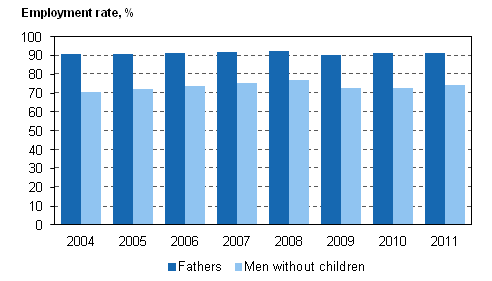
Figure 16. Unemployment rates for 20 to 59-year-old fathers and men without children in 2004-2011
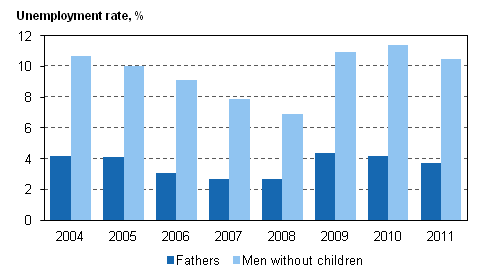
Unlike with men, the difference between the employment rates for women without children and for mothers was very small. The employment rates of mothers aged 20 to 59 and women without children in the same age group have remained between good 70 per cent and close on 80 per cent. The effect of the economic downturn on women's employment rates was also considerably smaller than for men. (Figure 17.) Compared with mothers of children aged under 18, the unemployment rate of women without children has been somewhat greater. However, the unemployment rate of women without children has been smaller than that of men without children of the same age. (Figure 18.)
Figure 17. Employment rates for 20 to 59-year-old mothers and women without children in 2004-2011
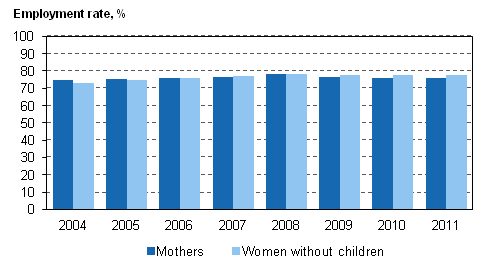
Figure 18.Unemployment rates for 20 to 59-year-old mothers and women without children in 2004-2011
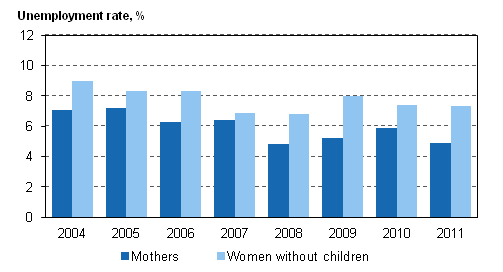
3.2 Mothers’ use of family leaves has become slightly more widespread
The age of the youngest child in the family has a distinct effect on the employment of mothers aged 20 to 59 (Figure 19). Only about one-half of mothers are employed if their youngest child is aged under three. Mothers’ employment rate rises to 90 per cent or so, i.e. to the same level as fathers’, only once the youngest child has reached school age. Fathers’ employment rate, in turn, remains equally high irrespective of the age of their children. This means that mothers still continue to take most of the long family leaves.
Figure 19. Employment rates for 20 to 59-year-old mothers by age of their youngest child in 2004-2011
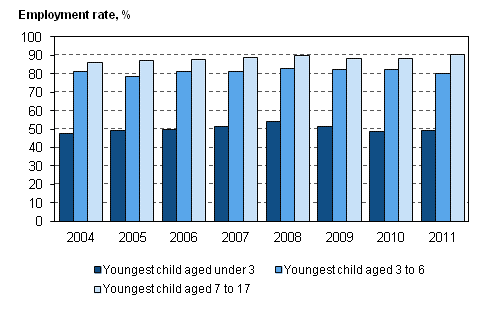
However, the employment rate alone does not describe the proportion of the parents of young children who actually work. Persons on maternity or paternity leave from work as well as persons whose absence from work has lasted under three months are classified as employed in the Labour Force Survey. Thus, especially in the case of mothers of very small children the employed contain many mothers who are actually at home looking after a child. Respectively, mothers on child care leave are mostly classified as inactive population (persons outside the labour force) because the care leave is often taken after the maternity leave and parental leave, which lengthens the total duration of the leave.
Figure 20 shows as a separate group those mothers of under three-year-old children who actually go to work. It also describes separately the mothers on family leave (maternity, parental or child care leave) from an employment relationship and the mothers without a valid employment contract who are looking after their children at home. The fourth group consists of those who have said their principal activity is something else than child care. This group includes such as students and unemployed persons.Figure 20. Working and family leaves of 20 to 59-year-old mothers with children aged under three in 2008-2011
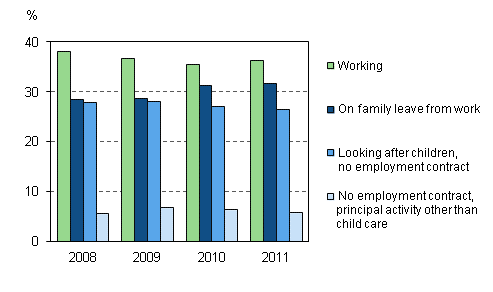
The economic downturn that started at the turn of 2008 and 2009 was reflected in the working of mothers of small children in that the share of those on family leaves grew slightly and correspondingly, that of those working fell to some extent. The situation in 2011 has remained more or less the same as in 2010. (Figure 20.)
When the mothers on family leaves are separated from those working, it can be seen that in reality only about one-third of the mothers of under three-year-olds were working in 2011. However, the groups of mothers of under one-year-olds and mothers of one to two-year-olds are very different (Figure 21). Of the mothers whose youngest child was aged under one, good eight per cent were working, over one-half were on family leave and good one-third were at home caring for the child and did not have a valid employment contract. When the youngest child was aged between one and two, as many as over one-half of the mothers were working. Thus, the share of mothers who work rises fast as the youngest child grows older when the mothers either return from family leave or find employment.
Figure 21. Working and family leaves among 20 to 59-year-old mothers by age of their youngest child in 2011
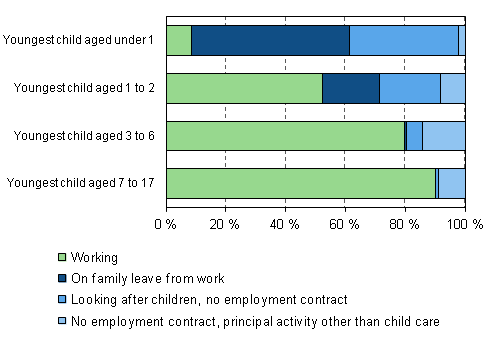
Fathers usually take shorter family leaves than mothers do. During the paternity leave, the “daddy” month or the care leave of under three months, fathers are classified as employed so family leaves have little impact on the employment rate of fathers. The picture of the employment of fathers hardly changes when the fathers on family leave are separated from the fathers who are working, because only two per cent of the fathers of under three-year-olds were on a family leave during the survey week in 2011.
3.3 More mothers stay at home after the arrival of third child
Apart from the age of children, their number also influences the employment of mothers (Figure 22). In 2011, 79 per cent of the mothers of two children were employed but only 64 per cent of mothers were still employed if there were at least three children. In 2009, the respective figures were 82 and 65 per cent. The number of children had no impact on the employment of fathers. In 2009, 92 per cent of the fathers of two children and 88 per cent of the fathers of three children were employed. The figures concern the age group of those aged 20 to 59.
Figure 22. Employment rates of fathers and mothers aged 20 to 59 by number of children in 2011
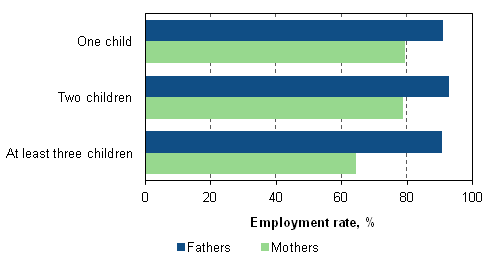
Indeed, staying at home is clearly more usual for the mothers of families with three or more children than among the mothers of families with one or two children. Around one in five of the mothers of families with at least three children were looking after their children at home and had no valid employment contract in 2011 (Figure 23). Working and looking after children were nearly equally common among the mothers of one or two children. Those mothers who did not have a valid employment contract said their principal activity was either child care or something else. Here mothers who have not had a valid employment contract and who said they primarily took care of they children were interpreted as being stay-at-home mothers.
Figure 23. Working and family leaves among 20 to 59-year-old mothers by number of children in 2011
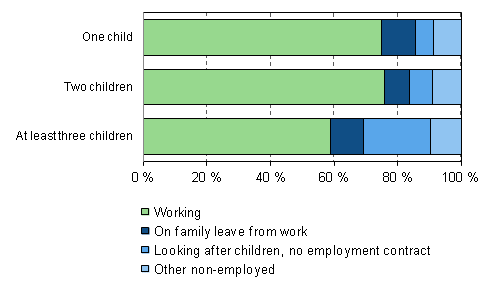
3.4 Both parents of families with children are usually employed
Both the father and the mother were employed in 70 per cent of the two-carer families with children in 2011. When the children are small, the father usually works and the mother stays at home caring for the children. However, this arrangement lasts for a relatively short time period and the so-called dual-earner model becomes usual when the youngest child grows older. When the youngest child is three to six years old, in 76 per cent of the two-parent families, both parents are employed and this was so for as many as 83 per cent of the parents of school-age children. (Figure 24).Figure 24. Labour market position of parents in families with children with two carers aged 20 to 59 by age of youngest child in 2011
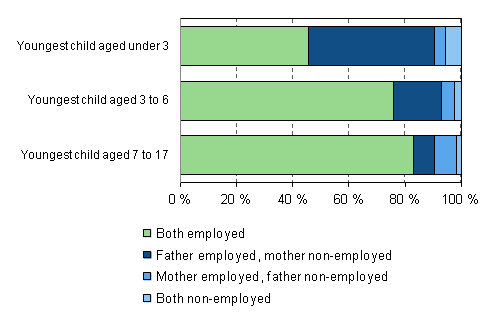
In four out of five of the two-parent families where the youngest child was aged under one the father was working and the mother was either on family leave or otherwise caring for children at home. When the youngest child was one to two years old, in every second family the mother had returned to work and only around one third of the mothers were on family leave or otherwise caring for children at home.
Thus, in respect of the parents’ participation in working life the set-up is still very traditional in the majority of families with small children. The mother was working while the father cared for the children in four per cent of the families with children aged under three in 2011.
3.5 The household section of the Labour Force Survey
The household section provides data on employment in families
The data presented in this chapter are based on the interview data obtained in the Labour Force Survey. In most European countries the Labour Force Survey data are collected from a sample of households, which means that all members of a household living at the same address are interviewed at the same time. Besides Finland, Sweden, Denmark and Switzerland are the only other countries where the sample is based on individual persons, i.e. only the target persons drawn into the sample are interviewed.
However, the EU regulation also requires data concerning households and in Finland this has been solved by exploiting the panel nature of the Labour Force Survey. In the Labour Force Survey the same person is usually interviewed five times during 18 months. In addition to the basic interview, a household interview is conducted on the fifth interview round to ascertain the members who belong to the household of the interviewee and the activity of the household members aged 15 to 74 on the labour market. The data obtained in this way enable examinations of, for instance, employment in the family and the joint status of both spouses on the labour market. However, this chapter centres only on families whose parents belong to the age group of those aged 20 to 59.
In 2011, the household data comprised approximately 55,000 persons who formed 23,000 households. The household data for the Labour Force Survey have been collected by the present method since 2003 and the data can mainly be published starting from the year 2004.
Concepts and definitions relating to the Families and work in 2011 review
Parents of families with children are women and men with their own or their spouse’s children aged under 18 living in the same household.
Women and men without children are women and men without children aged under 18 living in the same household. Thus they include
-
Persons without any children
-
So-called remote parents whose child lives or is registered at the address of the other parent and
-
Parents whose children are aged over 18 or have already moved into their own household.
More than 99 per cent of the parents of children aged under 18 locate in the age group of those aged 20 to 59, so this chapter examines parents belonging to that age group. Women and men of the same age without any children are used as their comparison group in order to make these groups comparable in respect of age and stage in life.
Family leaves comprise maternity and paternity leave, parental leave (incl. so-called “daddy” month) and child care leave. They are leaves for which the parents of small children are entitled to take by law from work in order to care for the child until the youngest child reaches the age of three. The employment contracts of the parents remain valid during these family leaves. Persons on maternity or paternity leave and persons on leaves lasting under three months are classified as employed in the Labour Force Survey.
Caring for children, no employment relationship : These persons do not have an employment relationship and in the interview they have reported child care as their principal activity.
No employment relationship, principal activity other than child care : These persons do not have an employment relationship and in the interview they have reported other than child care as their principal activity. This group includes such as students and unemployed persons.
Source: Labour force survey 2011. Statistics Finland
Inquiries: Veli Rajaniemi 09 1734 3434, Heidi Melasniemi-Uutela 09 1734 2523, Tarja Nieminen 09 1734 3561, tyovoimatutkimus@stat.fi
Director in charge: Riitta Harala
Updated 6.11.2012
Official Statistics of Finland (OSF):
Labour force survey [e-publication].
ISSN=1798-7857. Time series data 2002-2011 2011,
3 Families and work in 2011
. Helsinki: Statistics Finland [referred: 26.4.2025].
Access method: http://stat.fi/til/tyti/2011/15/tyti_2011_15_2012-11-06_kat_003_en.html

